[English] 日本語
 Yorodumi
Yorodumi- PDB-5ow6: CryoEM structure of recombinant CMV particles with Tetanus-epitope -
+ Open data
Open data
- Basic information
Basic information
| Entry | Database: PDB / ID: 5ow6 | |||||||||
|---|---|---|---|---|---|---|---|---|---|---|
| Title | CryoEM structure of recombinant CMV particles with Tetanus-epitope | |||||||||
 Components Components |
| |||||||||
 Keywords Keywords | VIRUS LIKE PARTICLE / VLP / Vaccines / CryoEM / CMV | |||||||||
| Function / homology |  Function and homology information Function and homology informationT=3 icosahedral viral capsid / viral nucleocapsid / ribonucleoprotein complex / structural molecule activity / RNA binding Similarity search - Function | |||||||||
| Biological species |  Cucumber mosaic virus (cucumber mosaic cucumovirus) Cucumber mosaic virus (cucumber mosaic cucumovirus) | |||||||||
| Method | ELECTRON MICROSCOPY / single particle reconstruction / cryo EM / Resolution: 4.2 Å | |||||||||
 Authors Authors | Kotecha, A. / Stuart, D.I. / Backmann, M. | |||||||||
| Funding support |  United Kingdom, 2items United Kingdom, 2items
| |||||||||
 Citation Citation |  Journal: NPJ Vaccines / Year: 2017 Journal: NPJ Vaccines / Year: 2017Title: Incorporation of tetanus-epitope into virus-like particles achieves vaccine responses even in older recipients in models of psoriasis, Alzheimer's and cat allergy. Authors: Andris Zeltins / Jonathan West / Franziska Zabel / Aadil El Turabi / Ina Balke / Stefanie Haas / Melanie Maudrich / Federico Storni / Paul Engeroff / Gary T Jennings / Abhay Kotecha / David ...Authors: Andris Zeltins / Jonathan West / Franziska Zabel / Aadil El Turabi / Ina Balke / Stefanie Haas / Melanie Maudrich / Federico Storni / Paul Engeroff / Gary T Jennings / Abhay Kotecha / David I Stuart / John Foerster / Martin F Bachmann /    Abstract: Monoclonal antibodies are widely used to treat non-infectious conditions but are costly. Vaccines could offer a cost-effective alternative but have been limited by sub-optimal T-cell stimulation ...Monoclonal antibodies are widely used to treat non-infectious conditions but are costly. Vaccines could offer a cost-effective alternative but have been limited by sub-optimal T-cell stimulation and/or weak vaccine responses in recipients, for example, in elderly patients. We have previously shown that the repetitive structure of virus-like-particles (VLPs) can effectively bypass self-tolerance in therapeutic vaccines. Their efficacy could be increased even further by the incorporation of an epitope stimulating T cell help. However, the self-assembly and stability of VLPs from envelope monomer proteins is sensitive to geometry, rendering the incorporation of foreign epitopes difficult. We here show that it is possible to engineer VLPs derived from a non human-pathogenic plant virus to incorporate a powerful T-cell-stimulatory epitope derived from Tetanus toxoid. These VLPs (termed CMV) retain self-assembly as well as long-term stability. Since Th cell memory to Tetanus is near universal in humans, CMV-based vaccines can deliver robust antibody-responses even under limiting conditions. By way of proof of concept, we tested a range of such vaccines against chronic inflammatory conditions (model: psoriasis, antigen: interleukin-17), neurodegenerative (Alzheimer's, β-amyloid), and allergic disease (cat allergy, Fel-d1), respectively. Vaccine responses were uniformly strong, selective, efficient , observed even in old mice, and employing low vaccine doses. In addition, randomly ascertained human blood cells were reactive to CMV-VLPs, confirming recognition of the incorporated Tetanus epitope. The CMV-VLP platform is adaptable to almost any antigen and its features and performance are ideally suited for the design of vaccines delivering enhanced responsiveness in aging populations. | |||||||||
| History |
|
- Structure visualization
Structure visualization
| Movie |
 Movie viewer Movie viewer |
|---|---|
| Structure viewer | Molecule:  Molmil Molmil Jmol/JSmol Jmol/JSmol |
- Downloads & links
Downloads & links
- Download
Download
| PDBx/mmCIF format |  5ow6.cif.gz 5ow6.cif.gz | 115.8 KB | Display |  PDBx/mmCIF format PDBx/mmCIF format |
|---|---|---|---|---|
| PDB format |  pdb5ow6.ent.gz pdb5ow6.ent.gz | 88.5 KB | Display |  PDB format PDB format |
| PDBx/mmJSON format |  5ow6.json.gz 5ow6.json.gz | Tree view |  PDBx/mmJSON format PDBx/mmJSON format | |
| Others |  Other downloads Other downloads |
-Validation report
| Summary document |  5ow6_validation.pdf.gz 5ow6_validation.pdf.gz | 990.3 KB | Display |  wwPDB validaton report wwPDB validaton report |
|---|---|---|---|---|
| Full document |  5ow6_full_validation.pdf.gz 5ow6_full_validation.pdf.gz | 993.3 KB | Display | |
| Data in XML |  5ow6_validation.xml.gz 5ow6_validation.xml.gz | 28.9 KB | Display | |
| Data in CIF |  5ow6_validation.cif.gz 5ow6_validation.cif.gz | 41.1 KB | Display | |
| Arichive directory |  https://data.pdbj.org/pub/pdb/validation_reports/ow/5ow6 https://data.pdbj.org/pub/pdb/validation_reports/ow/5ow6 ftp://data.pdbj.org/pub/pdb/validation_reports/ow/5ow6 ftp://data.pdbj.org/pub/pdb/validation_reports/ow/5ow6 | HTTPS FTP |
-Related structure data
| Related structure data |  3855MC M: map data used to model this data C: citing same article ( |
|---|---|
| Similar structure data |
- Links
Links
- Assembly
Assembly
| Deposited unit | 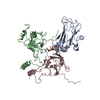
|
|---|---|
| 1 | x 60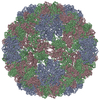
|
| 2 |
|
| 3 | x 5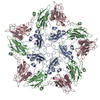
|
| 4 | x 6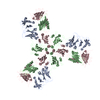
|
| 5 | 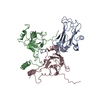
|
| Symmetry | Point symmetry: (Schoenflies symbol: I (icosahedral)) |
- Components
Components
| #1: Protein | Mass: 16924.420 Da / Num. of mol.: 1 Source method: isolated from a genetically manipulated source Details: PGYTFTSITLKPPKIDRGSYYGKRLLLPDSVTEYDKKLVSRLQIRVNPLPKFDSTVWVTVRKVPASSDLSVAAISAMFADGASPVLVYQYAASGVQANNKLLYDLSAMRADIGDMRKYAVLVYSKDDALETDELVLHVDIEHQRIPTSGVLPV Source: (gene. exp.)  Cucumber mosaic virus (cucumber mosaic cucumovirus) Cucumber mosaic virus (cucumber mosaic cucumovirus)Production host:  |
|---|---|
| #2: Protein | Mass: 21068.152 Da / Num. of mol.: 1 Source method: isolated from a genetically manipulated source Source: (gene. exp.)  Cucumber mosaic virus (cucumber mosaic cucumovirus) Cucumber mosaic virus (cucumber mosaic cucumovirus)Gene: CP / Production host:  |
| #3: Protein | Mass: 21139.229 Da / Num. of mol.: 1 Source method: isolated from a genetically manipulated source Source: (gene. exp.)  Cucumber mosaic virus (cucumber mosaic cucumovirus) Cucumber mosaic virus (cucumber mosaic cucumovirus)Gene: CP / Production host:  |
-Experimental details
-Experiment
| Experiment | Method: ELECTRON MICROSCOPY |
|---|---|
| EM experiment | Aggregation state: PARTICLE / 3D reconstruction method: single particle reconstruction |
- Sample preparation
Sample preparation
| Component | Name: CryoEM structure of recombinant CMV particles with Tetanus-epitope Type: VIRUS / Entity ID: all / Source: RECOMBINANT |
|---|---|
| Molecular weight | Experimental value: NO |
| Source (natural) | Organism:  cucumber mosaic cucumovirus (cucumber mosaic cucumovirus) cucumber mosaic cucumovirus (cucumber mosaic cucumovirus) |
| Source (recombinant) | Organism:  |
| Details of virus | Empty: YES / Enveloped: NO / Isolate: OTHER / Type: VIRUS-LIKE PARTICLE |
| Natural host | Organism: Cucumis sativus |
| Virus shell | Triangulation number (T number): 1 |
| Buffer solution | pH: 9 / Details: 5 mM sodium borate, 2 mM EDTA, pH 9 |
| Specimen | Conc.: 2.5 mg/ml / Embedding applied: NO / Shadowing applied: NO / Staining applied: NO / Vitrification applied: YES / Details: 5 mM sodium borate, 2 mM EDTA, pH 9 |
| Specimen support | Grid material: COPPER / Grid mesh size: 200 divisions/in. / Grid type: C Flats 2/1 2C |
| Vitrification | Instrument: FEI VITROBOT MARK IV / Cryogen name: ETHANE / Humidity: 90 % / Chamber temperature: 293 K |
- Electron microscopy imaging
Electron microscopy imaging
| Experimental equipment |  Model: Tecnai Polara / Image courtesy: FEI Company |
|---|---|
| Microscopy | Model: FEI POLARA 300 |
| Electron gun | Electron source:  FIELD EMISSION GUN / Accelerating voltage: 300 kV / Illumination mode: FLOOD BEAM FIELD EMISSION GUN / Accelerating voltage: 300 kV / Illumination mode: FLOOD BEAM |
| Electron lens | Mode: BRIGHT FIELD / Nominal magnification: 160000 X / Calibrated magnification: 37037 X / Nominal defocus max: 4000 nm / Nominal defocus min: 1500 nm / Cs: 2 mm / C2 aperture diameter: 50 µm / Alignment procedure: BASIC |
| Specimen holder | Cryogen: NITROGEN Specimen holder model: GATAN 910 MULTI-SPECIMEN SINGLE TILT CRYO TRANSFER HOLDER Temperature (max): 70 K / Temperature (min): 70 K |
| Image recording | Average exposure time: 5 sec. / Electron dose: 20 e/Å2 / Detector mode: COUNTING / Film or detector model: GATAN K2 SUMMIT (4k x 4k) / Num. of grids imaged: 1 / Num. of real images: 500 |
| EM imaging optics | Energyfilter name: GIF / Energyfilter upper: 20 eV / Energyfilter lower: 0 eV |
| Image scans | Sampling size: 5 µm / Width: 3838 / Height: 3710 / Movie frames/image: 25 / Used frames/image: 2-25 |
- Processing
Processing
| Software | Name: PHENIX / Version: dev_2645: / Classification: refinement | ||||||||||||||||||||||||||||||||||||||||
|---|---|---|---|---|---|---|---|---|---|---|---|---|---|---|---|---|---|---|---|---|---|---|---|---|---|---|---|---|---|---|---|---|---|---|---|---|---|---|---|---|---|
| EM software |
| ||||||||||||||||||||||||||||||||||||||||
| CTF correction | Type: PHASE FLIPPING AND AMPLITUDE CORRECTION | ||||||||||||||||||||||||||||||||||||||||
| Particle selection | Num. of particles selected: 6600 | ||||||||||||||||||||||||||||||||||||||||
| Symmetry | Point symmetry: I (icosahedral) | ||||||||||||||||||||||||||||||||||||||||
| 3D reconstruction | Resolution: 4.2 Å / Resolution method: FSC 0.143 CUT-OFF / Num. of particles: 3582 / Algorithm: BACK PROJECTION / Num. of class averages: 1 / Symmetry type: POINT | ||||||||||||||||||||||||||||||||||||||||
| Atomic model building | B value: 174 / Protocol: RIGID BODY FIT / Space: REAL / Target criteria: Cross-correlation coefficient | ||||||||||||||||||||||||||||||||||||||||
| Refine LS restraints |
|
 Movie
Movie Controller
Controller


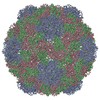
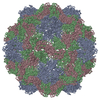
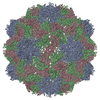
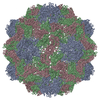
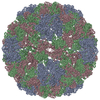
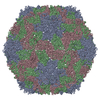
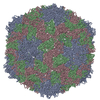
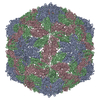

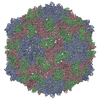
 PDBj
PDBj

